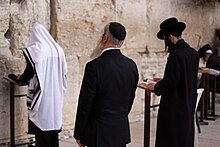Nuhilik


Nuhilik, Nuh'un Evrensel Yasalarını ve kendi Ortodoks Yahudilik yorumlarını[1] temel alan tektanrıcı Yahudi dinsel harekettir.[2][3][4][5][6] Yahudi yasalarına göre, Yahudi olmayanların (Centil) Yahudiliğe (Yahudi Milletine) katılması zorunlu değildir ancak Nuh'un yedi yasasına Tevrat ile uymaları gerekir.
Nuh'un yedi yasası
Nuh Ahitinin, Babil Talmud'unda (Avodah Zarah 8:4, Sanhedrin 56a-b) sıralanan yedi emri şunlardır:[1][7][8][9]
- Putlara tapmayın.[1][7][8][9]
- Tanrı'ya lanet etme,Tanrın Aşem’e İnan ve ona ibadet et.[1][7][8][9]
- Öldürmeyin.[1][7][8][9]
- Zina veya cinsel ahlaksızlık yapmayın.[1][7][8][9]
- Çalmayın.[1][7][8][9]
- Canlı bir hayvanın etini yemeyin.[1][7][8][9]
- Adaleti tesis edin.[1][7][8][9][10]
Kaynakça
- ^ a b c d e f g h i Singer, Isidore; Greenstone, Julius H. (1906). "Noachian Laws". Jewish Encyclopedia. Kopelman Foundation. 5 Şubat 2012 tarihinde kaynağından arşivlendi. Erişim tarihi: 10 Kasım 2020.
- ^ Feldman, Rachel Z. (8 Ekim 2017). "The Bnei Noah (Children of Noah)". World Religions and Spirituality Project. 21 Ocak 2020 tarihinde kaynağından arşivlendi. Erişim tarihi: 3 Kasım 2020.
- ^ Feldman, Rachel Z. (August 2018). "The Children of Noah: Has Messianic Zionism Created a New World Religion?" (PDF). Nova Religio: The Journal of Alternative and Emergent Religions. Berkeley: University of California Press. 22 (1): 115-128. doi:10.1525/nr.2018.22.1.115. 26 Mayıs 2021 tarihinde kaynağından arşivlendi. Erişim tarihi: 31 Mayıs 2020 – Project MUSE vasıtasıyla.
- ^ Kress, Michael (2018). "The Modern Noahide Movement". My Jewish Learning. 12 Mayıs 2015 tarihinde kaynağından arşivlendi. Erişim tarihi: 31 Mayıs 2020.
- ^ Strauss, Ilana E. (26 Ocak 2016). "The Gentiles Who Act Like Jews: Who are these non-Jews practicing Orthodox Judaism?". Tablet Magazine. 26 Ekim 2018 tarihinde kaynağından arşivlendi. Erişim tarihi: 31 Ekim 2020.
- ^ Tabachnick, Toby (22 Temmuz 2010). "Noahides establish website for interested followers". The Jewish Chronicle of Pittsburgh. Pittsburgh, Pennsylvania. 5 Kasım 2020 tarihinde kaynağından arşivlendi. Erişim tarihi: 31 Ekim 2020.
- ^ a b c d e f g h Reiner, Gary (2011) [1997]. "Ha-Me'iri's Theory of Religious Toleration". Laursen, John Christian; Nederman, Cary J. (Ed.). Beyond the Persecuting Society: Religious Toleration Before the Enlightenment. Philadelphia: University of Pennsylvania Press. ss. 86-87. doi:10.9783/9780812205862.71. ISBN 978-0-8122-0586-2.
- ^ a b c d e f g h Berkowitz, Beth (2017). "Approaches to Foreign Law in Biblical Israel and Classical Judaism through the Medieval Period". Hayes, Christine (Ed.). The Cambridge Companion to Judaism and Law. New York City: Cambridge University Press. ss. 147-149. ISBN 978-1-107-03615-4. LCCN 2016028972.
- ^ a b c d e f g h "Noahide Laws". Encyclopædia Britannica. Edinburgh: Encyclopædia Britannica, Inc. 14 Ocak 2008. 21 Ocak 2016 tarihinde kaynağından arşivlendi. Erişim tarihi: 10 Kasım 2020.
Noahide Laws, also called Noachian Laws, a Jewish Talmudic designation for seven biblical laws given to Adam and to Noah before the revelation to Moses on Mt. Sinai and consequently binding on all mankind.
Beginning with Genesis 2:16, the Babylonian Talmud listed the first six commandments as prohibitions against idolatry, blasphemy, murder, adultery, and robbery and the positive command to establish courts of justice (with all that this implies). After the Flood a seventh commandment, given to Noah, forbade the eating of flesh cut from a living animal (Genesis 9:4). Though the number of laws was later increased to 30 with the addition of prohibitions against castration, sorcery, and other practices, the "seven laws", with minor variations, retained their original status as authoritative commandments and as the source of other laws. As basic statutes safeguarding monotheism and guaranteeing proper ethical conduct in society, these laws provided a legal framework for alien residents in Jewish territory. Maimonides thus regarded anyone who observed these laws as one "assured of a portion in the world to come." - ^ "Sanhedrin 56". Babylonian Talmud. Halakhah. 13 Nisan 2010 tarihinde kaynağından arşivlendi.











